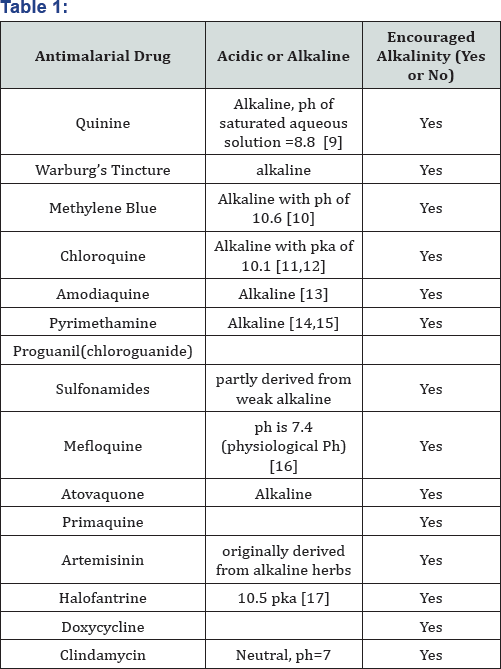Antimalarials Validate the Germ Terrain Duality Theory
Mister Seun Ayoade*
University of Ibadan, Nigeria
Submission: July 22, 2017; Published: August 10, 2017
*Corresponding author: Mister Seun Ayoade, University of Ibadan, Nigeria, Email: seunoodua@yahoo.com
How to cite this article: Mister S A. Antimalarials Validate the Germ Terrain Duality Theory. JOJ Nurse Health Care. 2017; 2(5): 555600. DOI: 10.19080/JOJNHC.2017.02.555600
Opinion
The Germ-Terrain duality theory of disease states that the etiology of certain diseases/diseased states is better explained as a complex interplay between germs and the inherent anatomical/physiological integrity of the body cell [1,2].
It argues that the etiology of certain diseases is not fully explained merely by the presence of germs (Germ Theory) or by a mere loss of cellular integrity (Terrain Theory) [1,2]. As a result the prevention and treatment of such diseases should focus not just on fighting germs but on maintaining/restoring the anatomical/physiological cellular integrity. The Germ-Terrain duality theory is a harmonization of the current Germ Theory (popularized by Loius Pasteur) and the hitherto discarded Terrain Theory (popularized by Pierre Bechamp).
The terrain theory is the theory of disease proposed by Antoine Bechamp that a diseased body, the «terrain», will attract germs to come as scavengers of the weakened or poorly defended tissue. Bechamp postulated that the pH of the body is important, and that an acidic pH will attract germs and an alkaline pH will repel them.
PH is a measure of acidity or alkalinity. A Ph >7 is alkaline, ph <7 is acidic. A ph of 7 is neutral. Normal Ph of blood is 7.357.45. During malaria blood ph becomes lower. Malaria causes blood ph to drop causing acidosis. Metabolic acidosis is a common complication of severe malaria caused by Plasmodium falciparum [3].
Cell/tissue damage and death reduces PH, attracting plasmodium (if already present), whose vesicles are acidic. Cell damage and death is associated with reduced ph [4].
The antimalarial chloroquine attacks/destroys plasmodium by increasing the ph of the vesicles in plasmodium falciparum [5-7]. Just Reducing ph of blood to 5.5 (in vitreo, and for monkeys) kills plasmodium, even without utilizing antimalarials [8] (Table 1) [9-17]!

Virtually all the drugs used to treat malaria through the ages were either alkaline or encouraged alkalinity of the blood/body cells or of the parasites within the cells viz.
Conclusion
As defined in the Germ Terrain Duality Theory, the PH of blood is important. Antimalarials through the ages have waged a PH war.
References
- Ayoade S (2017) Germ-terrain duality of sickness, equivalent of wave- particle duality of light for the biological sciences? Bechamp revisited. Int J Anat Var 10(1): 10-11.
- (2017) Journal of Molecular and Genetic medicine 11: 2.
- Sasi P, Burns SP, Waruiru C, English M, Hobson CL (2007) Metabolic acidosis and other determinants of hemoglobin-oxygen dissociation in severe childhood Plasmodium falciparum malaria. Am J Trop Med Hyg 77(2): 256-260.
- Kuzman D, Znidarcic T, Gros M, Vrhovec S, Svetina S, et al. (2000) Effect of pH on red blood cell deformability. Pflugers Arch 440(5): R193-R194.
- Krogstad DJ, Schlesinger PH, Gluzman IY (1985) Antimalarials increase vesicle pH in Plasmodium falciparum. J Cell Biol 101(6): 2302-2309.
- Yayon A, Cabantchik ZI, Ginsburg (1985) Susceptibility of human malaria parasites to chloroquine is pH dependent. Proc Natl Acad Sci USA 82(9): 2784-2788.
- Krogstad DJ, Schlesinger PH (1987) The basis of antimalarial action: non-weak base effects of chloroquine on acid vesicle pH. Am J Trop Med Hyg 36(2): 213-220.
- William BW (1942) Respiratory and Carbohydrate Metabolism of Malaria Parasites (Plasmodium Knowlesi). Journal of Biological Chemistry, pp. 21-34.
- (2013) The Merck Index - An Encyclopedia of Chemicals, Drugs, and Biologicals. Cambridge, UK.
- Manabu S, Mitsuo I, Seizo Y (1994) Evaluation of the alkaline methylene blue staining method for yeast activity determination. Journal of Fermentation and Bioengineering 78(3): 212-216.
- http://logkow.cisti.nrc.ca/logkow/search.html
- Yayon A, Cabantchik ZI, Ginsburg (1985) Susceptibility of human malaria parasites to chloroquine is pH dependent. Proc Natl Acad Sci USA 82(9): 2784-2788.
- Ruscoe JE, Tingle MD, O'Neill PM, Ward SA, Park BK (1998) Effect of Disposition of Mannich Antimalarial Agents on Their Pharmacology and Toxicology. Antimicrob Agents Chemother 42(9): 2410-2416.
- Acid-Base Properties of Drugs.
- https://www.ebi.ac.uk/chembl/compound/inspect/CHEMBL120105
- Anton WJ (1998) Drugs, Photochemistry and Photostability. J Am Chem Soc 121(37): 8678.
- https://www.drugbank.ca/drugs/DB06708






























